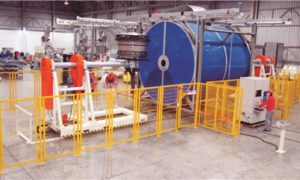These are the raw materials for rotomolding
The raw materials that are used in plastics rotomolding vary a lot in terms of physical properties and the applications they are meant to be used for. In order to achieve certain properties, additives are usually added into the polymers. The same also goes for color. In order to achieve, let’s say, color blue in the final product, additives for the blue color are usually added into the polymer.
There is a wide range of thermoplastic materials that are used in rotomolding in general. Of all the materials that can be used, the most commonly used material is polyethylene, often shortened as PE. There are several classifications and grades in which PE is provided. Examples of these classifications and grades include Cross Linked Polyethylene (XLPE), Medium Density Polyethylene (MDPE), High Density Polyethylene (HDPE), and Linear Low-Density Polyethylene (LLDPE). Before these materials are used in rotomolding, they have to be pulverized to a very fine powder. In most cases, this is done using a 35 mesh. Rotomolding is still hugely limited in the field of engineered resin even though improved technology now makes it possible to mold micropellets. You can look at micropellets are tinier version of pelletized material.
Other additional materials that you can use with rotational molding include vinyls, PVC, Nylons, polypropylene, and polycarbonates. Other materials are more rarely used and I don’t see the need to mention them here. Let us take a look at some of the materials that are used in this process in more detail below.

Polyethylene
If you have any hope of understanding polyethylene plastics, you have to understand one other material first, that is, thermosoftening plastics, more commonly referred to as thermoplastics. Like the name insinuates, these are the kind of plastic materials that become soft, moldable, or pliable when heat is applied to them. They must be heated to a certain temperature in order for them to soften up and if the heat continues to be applied, they break down to form a thick, viscous fluid.
Once these plastics have become soft, they can be reshaped into any form one wants as opposed to thermosetting plastics which don’t. The ability of thermoplastics to be shaped into various forms lends them to be used in a wide range of processes used to manufacture plastics such as rotomolding, compression molding, and injection molding.
Thermosets materials
Thermoset materials are not the same as thermoplastics because they do not recover or allow to be reshaped when they are heated. When they are heated, they simply decompose and do not recover when they cool down. This makes them not suitable for use in rotomolding process.
Classification of polyethylene plastics
Polyethylene plastics can be classified into a few classes as discussed below. These classes characterize the materials so that they are suitable for different applications. These classes include LLDPE, MDPE, HDPE, LDPE, and XLPE. LLDPE stands for Linear Low Density Polyethylene, MDPE stands for Medium Density Polyethylene, HDPE stands for High Density Polyethylene, LDPE stands for Low Density Polyethylene, and XLPE stands for Cross Link Polyethylene.